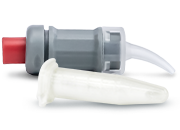
The American Academy of Pediatrics (AAP), jointly with the American Academy of Pediatric Dentistry (AAPD), clearly state that for children who are deeply sedated, the sedation provider “must be trained in and capable of providing advanced pediatric life support and is skilled to rescue a child with apnea, laryngospasm, and/or airway obstruction. Required skills include the ability to open the airway, suction secretions, provide CPAP, insert supraglottic devices (oral airway, nasal trumpet, LMA), and perform successful bag-valve-mask ventilation, tracheal intubation, and cardiopulmonary resuscitation.” A second individual must be a trained observer “whose only responsibility is to constantly observe the patient’s vital signs, airway patency, and adequacy of ventilation and to either administer drugs or direct their administration. This individual must be trained in PALS and capable of assisting with any emergency that might arise.” An individual, including dental assistants, without formal and extensive medical training does not meet the AAP/AAPD standards of being capable of assisting with a medical emergency.
In 2015, 6-year-old Caleb Sears died in his oral surgeon’s office. He had received multiple sedating medications, including propofol, ketamine and midazolam. When Caleb either obstructed his airway or stopped breathing, the oral surgeon failed to administer reversal or resuscitative agents, failed to attempt placement of a supraglottic device, and failed to ventilate or intubate. In fact, when the EMTs arrived, Caleb was pulseless, and no one was performing basic CPR. As a result of his death, Caleb’s Law (calebslaw.org) was passed in the State of California. The law required three things regarding deep sedation or anesthesia for children:
1. A study by the Dental Board of California on current practices, incidence of adverse events and the safety of dental anesthesia. 2. A data-collection tool to gather reliable information on dental anesthesia occurrences and adverse events. 3. An updated informed-consent form that explains to the patient’s parents or caregivers that delivering deep sedation or general anesthesia in a dental office is different from general anesthesia practiced in a hospital or accredited surgical center.
Following completion of the study by the Dental Board of California, there has been an attempt to codify these recommendations in Caleb’s Law 2 (California Assembly Bill AB224). Unfortunately, this process has been met with considerable resistance. There should be no misunderstanding regarding the skill set which the AAP/ AAPD guidelines require the independent observer to have. This individual must also be at least PALS trained and capable of assisting with emergencies for deeply sedated children. Specifically, PALS training includes recognizing and diagnosing heart rhythms, independent administration of resuscitative drugs, and directing or performing the delivery of any other rescue interventions (defibrillation, synchronized cardioversion, intraosseous access, etc).
Dental assistants or hygienists do not receive such training and therefore cannot fulfill the AAP/AAPD guideline recommendations. Yet, some in the oral surgery community feel that such a person fulfills the
AAP/AAPD guideline with minimal additional training. The oral surgery “team model” utilizing dental assistants is not in any way equivalent to the American Society of Anesthesiologists’ “team model” (see www.asahq.org/lifeline/who%20is%20a%20anesthesiologist/anes thesia%20care%20team) for anesthesia care.
Furthermore, on every box of Diprivan (propofol) Injectable Emulsion—a drug used commonly for inducing deep sedation and/or general anesthesia in office-based settings—the FDA has mandated that the following language be displayed prominently:
DIPRIVAN injection should be administered only by persons trained in the administration of general anesthesia and not involved in the conduct of the surgical/diagnostic procedure.
Notwithstanding the fact that other medications can place children into deep sedation or general anesthesia, the warning on this product certainly seems to be very prudent. In fact, the expectations of the vast majority of parents and caretakers are that their child’s deep sedation/general anesthesia is being administered and/or monitored by someone explicitly trained to do so while their dentist or oral surgeon performs the dental procedure.
We have arrived at a critical juncture in the provision of deep sedation and general anesthesia in numerous places throughout the United States and Canada where the root-cause analysis of high-profile bad outcomes and adverse events has highlighted the suboptimal practices currently occurring in many dental and oral surgery offices. How is it still acceptable—as is often typical in oral surgery practice—that the dentist extracting the tooth or performing the oral surgery procedure is simultaneously tasked with the ultimate responsibility of both administering and monitoring general anesthesia, particularly in young children?
Obviously, this practice model is profitable, since the oral surgeon is able to bill separately for the procedure and for the administration of anesthesia. An argument has been proposed stating that well-trained dental assistants are surrogates for the training and judgment of an oral surgeon who may have spent up to six months in a hospital setting learning a separate-provider model of general anesthesia under the strict tutelage of physician-led training programs. But dental assistants, no matter how well trained they may be, have not had the medical training required to assist with life-threatening emergencies and are incapable of assuming the responsibility for making important clinical—sometimes critical—decisions that rely on adequate medical experience.
Dental assistants and auxiliaries cannot possibly have the extensive knowledge or thorough understanding of physiology and pharmacology that has made anesthesia/ sedation in other settings so safe. Dental assistants, unlike registered nurses, generally are not trained to start an intravenous line; nor are they allowed to independently administer drugs intravenously in most jurisdictions. In terms of scope of practice, they are therefore severely limited in their ability to assist in a true, life-threatening pediatric emergency.
Another nuance we must consider is that in any pediatric medical emergency, the timeline of an unfolding crisis is accelerated. The loss of an open air way due to a laryngospasm, pharyngeal collapse or apnea, the hypotension from anaphylaxis, or the development of seizures caused by fever or local anesthetic overdose, requires a more rapid intervention than is the case when treating someone older. The need for this accelerated response when treating children is due to pediatric patients’ greater oxygen consumption and the rapidity with which they may develop severe hypoxemia. It is simply unrealistic to think that a dental provider will be able to insert an IV or administer rescue medications while simultaneously attempting to manage the airway, perform chest compressions, or handle any other evolving medical emergency alone. Surgeons with bravado may seem capable and willing, but when we recognize the hubris of this attitude and insist on the principle of “one person dedicated to one task,” better outcomes will be the result.
Societies committed to the highest standards in pediatric safety in the area of deep sedation and general anesthesia or will we recommit to providing best-practices in WORST-BEST OPTION, PEDIATRIC Will we be satisfied with the O R ANESTHEISA SAFETY?
We believe that parents—if given the option of having a separate anesthesia provider who has expertise in managing pediatric patients under general anesthesia and uses these skills regularly instead of only occasionally—would undoubtedly reject the single-provider model. Caleb’s Law in California was meant to make all dental patients and their caregivers aware of safer options.
The American Academy of Pediatrics, the American Academy of Pediatric Dentistry, the American Society of Anesthesiologists, and the American Society of Dentist Anesthesiologists have all made firm and unwavering commitments to promoting pediatric patient safety in the area of deep sedation and general anesthesia. The FDA has also made their commitment to this goal exceedingly clear.
No matter what arguments have been or will be proposed, the standard of care endorsed by these professional societies and by the federal government clearly indicate that the practice of adopting a single-operator anesthesia model to provide general anesthesia in dentistry is the least-best option— perhaps the best-worst option—we can offer to our children in terms of safety and outcomes. It is unclear if a “black box warning” from the FDA would improve patient safety or alter current practice. However, it might be a step in the right direction by emphasizing that, as wonderful as anesthetic drugs are, they also can be a loaded gun fired by an untrained or minimally trained individual, potentially leading to subsequent tragic consequences.

